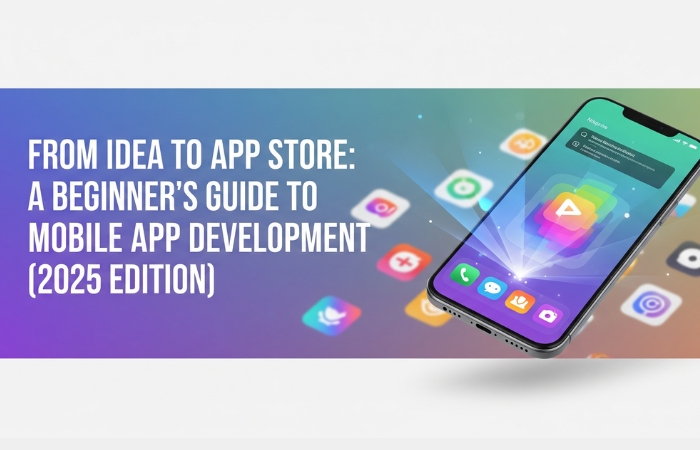
From Idea to App Store: A Beginner’s Guide to Mobile App Development (2025 Edition)
Do you have a great mobile app idea but don’t know where to start? You’re not alone. Mobile apps are a booming industry—expected to surpass $567 billion in global revenue by 2030. But turning your concept into a live app on the App Store or Google Play takes more than just a dream.
In this beginner-friendly guide, we’ll walk you through every stage of mobile app development, from ideation to launch and maintenance. Whether you’re a startup founder or a curious entrepreneur, this roadmap is for you.
Step 1: Validate Your App Idea
Before diving into design or code, validate that your idea solves a real problem.
Key Questions:
- What problem does the app solve?
- Who is your target audience?
- What are competing apps doing—and missing?
- Is the market growing?
Tools for Market Research:
- Surveys: Google Forms, SurveyMonkey
- Interviews: Talk directly with potential users
- Competitor Analysis: App Store reviews, SimilarWeb
- Trends: Google Trends, Statista
Pro Tip: Conduct a SWOT analysis to assess your app idea’s strengths and market position.
Estimated Timeline: 1–4 weeks
Step 2: Wireframing & Prototyping
Once your idea is validated, it’s time to visualize the user experience.
Wireframes:
- Outline basic screen layouts and user journeys.
- Tools: Balsamiq, Miro
Prototypes:
- Interactive mockups that simulate app behavior.
- Tools: Figma, Adobe XD, InVision.
UX Tips for 2025:
- Design for mobile-first
- Use simple navigation
- Focus on accessibility and micro-interactions
- Ensure fast loading and responsive behavior
Estimated Timeline: 2–6 weeks
Step 3: Define Your MVP (Minimum Viable Product)
Don’t build every feature at once. Launch a Minimum Viable Product that delivers your app’s core value.
MVP Strategy:
- Focus on one main use case.
- Prioritize feedback collection.
- Delay non-essential features to Phase 2.
Why MVP First?
It reduces costs, shortens time-to-market, and helps validate the product before scaling.
Step 4: Choose the Right Technology Stack
Your tech stack affects app performance, cost, and future scalability.
Frontend Approaches:
| Option | Best For | Tech | Pros | Cons |
| Native | iOS/Android individually | Swift, Kotlin | High performance | Expensive |
| Cross-platform | One app for both | Flutter, React Native | Faster dev, lower cost | Slight perf loss |
| PWA | Lightweight use | HTML5, JS | Low dev cost | Limited features |
Backend & Database:
- Firebase / AWS Amplify – Fast launch, managed hosting
- Node.js / Django / Laravel – Full control and scalability
- Firestore / PostgreSQL / MongoDB – Based on app needs
Step 5: App Development Begins
Now the actual building starts.
Development Tasks:
- Frontend (UI development)
- Backend (servers, APIs, data)
- Database & cloud storage
- Authentication, analytics
Tools Used:
- GitHub or GitLab for version control
- Jira/Trello for task management
Estimated Timelines:
- Basic App: 2–4 months
- Medium App: 4–7 months
- Complex App: 7–12+ months
Step 6: Testing & Quality Assurance
Your app must work flawlessly before launch.
Test For:
- Functionality
- Speed & performance
- Security vulnerabilities
- Device and OS compatibility
- User experience
- Crash logs
Testing Tools:
- TestFlight (iOS)
- Firebase Crashlytics
- Appium, BrowserStack
Estimated Timeline: 2–8 weeks
Step 7: App Store Deployment
Ready to launch? Here’s how to submit your app to the app stores.
Google Play Store:
- Developer Account: $25 (one-time)
- File Format: .AAB or .APK
- Review Time: 3–6 days
Apple App Store:
- Developer Program: $99/year
- Upload via Xcode/TestFlight
- Review Time: 2–15 days
App Store Optimization (ASO) Tips:
- Use primary and secondary keywords naturally.
- Write a benefit-focused description.
- Upload sharp screenshots and a short app video.
- Encourage early reviews post-launch.
Estimated Timeline: 1–4 weeks
Step 8: Post-Launch Maintenance & Growth
The work doesn’t stop after launch.
Key Activities:
- Fix bugs and roll out updates.
- Monitor app performance (GA4, Firebase).
- Analyze user behavior with Mixpanel or Amplitude.
- Add new features based on feedback.
- Run growth marketing campaigns (social ads, influencer promotions, email marketing).
Also consider App Store A/B testing for improving your listing conversion rate.
Mobile App Development Cost & Timeline (2025)
| App Type | Timeline | Estimated Cost |
| Simple MVP | 2–4 months | $25,000 – $50,000+ |
| Medium Complexity | 4–7 months | $50,000 – $150,000+ |
| High Complexity | 7–12+ months | $150,000 – $350,000+ |
Cost Breakdown:
- Strategy & Research: 5–10%
- UI/UX Design: 10–25%
- Development: 50–70%
- Testing: 10–15%
- Project Management: 5–10%
- Ongoing Maintenance: 15–25% yearly
Conclusion
Building an app can be complex, but with the right plan, tools, and partners, it’s absolutely achievable. This guide gave you the blueprint—from brainstorming to publishing.
Looking to build your mobile app in 2025? Let’s talk. Our development experts can help you strategize, design, and launch your app idea successfully.

